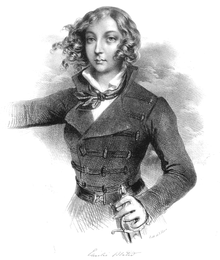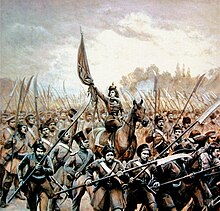Emilia Plater

Emilia Broel-Plater ( Polish Emilia Plater , Lithuanian Emilija Pliaterytė ; born November 13, 1806 in Wilna , † December 23, 1831 on the Justianowo estate near Lazdijai ) was a countess from the Dussiaty line of those von dem Broele, called Plater , and one Freedom fighter .
biography
Since 1815 she lived with her divorced mother with relatives in Lixten near Dünaburg in Livonia (today in Latvia ), where she and her cousins received lessons in fencing, horse riding and drawing. She was very well read and was enthusiastic about Polish patriotic literature, but also about Goethe and Schiller, which she could read in German. Her mother died in 1830, which was a severe blow to the young woman. When the news of the outbreak of the November Uprising in Warsaw arrived shortly afterwards , she and her cousin Cezary Plater organized an uprising among the local population, joined the volunteer hunters of Wilkomir and then Konstanty Parczewski's corps and became a captain (captain) in the 25th Line Regiment.
Emilia Plater fought in various battles, including a. at Kowno and Szawle and followed the corps of General Dezydery Chłapowski when the Polish army was divided until he entered Prussian territory. Emilia Plater tried to get to Warsaw with her cousin , but died as a result of the hardships suffered on December 23, 1831 and was buried in Kopciowo (today's Lithuanian Kapčiamiestis ). Her grave and a memorial there still remember her today.
Mention in literature and society
After her death, the Lithuanian-Polish Joan of Arc (as Emilia Plater was also called) was elevated to a symbolic figure of resistance against "Russian rule" in numerous literary works by Polish-Lithuanian authors. The prelude to this was Adam Mickiewicz's poem Śmierć pułkownika (“The Colonel's Death”), published in March 1832 in exile in Paris , the content of which, however, is pure fiction.
In 1842 JK Salomoński published a short biography on Emilia Plater in New York . In addition, various painters also took on the "fighting heroine", including Wojciech Kossak , from whom numerous pictures of historical subjects come. Emilie Plater was also depicted on a banknote from the Second Polish Republic , and during the Second World War a Polish military unit bore her name.
Even in post-war Poland, she was named after a ship of the Polish Navy.
Even today, numerous streets and squares are named after her in Poland.
Footnotes
- ↑ PLATER BROEL hr. Austr. 1774 r., Hr. Prus. 1862 r., Pw.tyt. hr. w Rosji 1829, 1838, 1843, 1852, 1855, 1859 i 1860 rh PLATER, 1460; Rodzina westfalska, właściwa jej nazwa from the Broele called Plater, około 1300 r. w Inflantach. in: Janusz Starykoń-Kasprzycki, Michał Dmowski. Polska encyklopedia szlachecka. 1937. cz. 9 p. 361
Web links
- Plater . In: Meyers Konversations-Lexikon . 4th edition. Volume 13, Verlag des Bibliographisches Institut, Leipzig / Vienna 1885–1892, p. 118.
- Mervyn B. de Plater: Emilia Plater ( Memento from August 14, 2011 in the Internet Archive ), Brisbane 1998 (English)
- Jósef Straszéwicz: The life of the Countess Emily Plater . Translated by JK Salomonski. New York, 1843
- Marcel Bouteron : La Jeanne d'Arc de Pologne, Émilie Plater (1806–1831)
- Doris Liebermann : Die Partisanin , Die Zeit , September 2, 2010, No. 36, p. 20.
| personal data | |
|---|---|
| SURNAME | Plater, Emilia |
| ALTERNATIVE NAMES | Platerówna, Emilia; Pliaterytė, Emilija |
| BRIEF DESCRIPTION | Polish-Lithuanian countess |
| DATE OF BIRTH | November 13, 1806 |
| PLACE OF BIRTH | Vilna |
| DATE OF DEATH | December 23, 1831 |
| Place of death | Justinava estate near Vainežeris , Lithuania |

